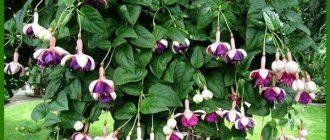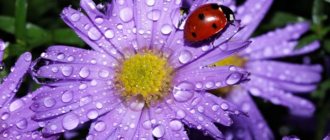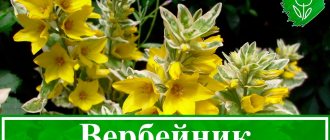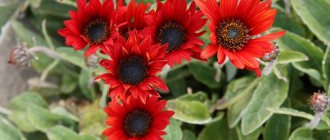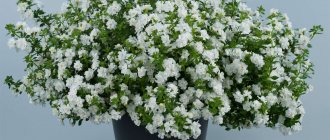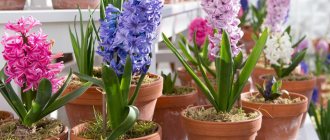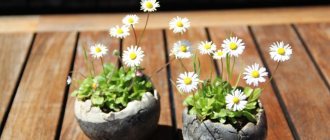Astra has gained its popularity due to its unpretentiousness, beauty and variety of colors. Starting from the second half of summer until frost, it delights gardeners with flowering, especially in the fall, when many flowers have already faded. Many varieties and species have been developed. This diversity allows you to grow it not only in flower beds, but also to decorate terraces and balconies. When studying flowers, schoolchildren are often asked to write a report on the topic “Aster - description of a flower.” This way children learn this topic better.
Description of the perennial flower Astra
Thanks to the pointed shape of the petals, collected in a lush inflorescence, asters are associated with celestial stars. Many poets and writers sang its beauty in their works, and in ancient times the aster was endowed with mystical, symbolic qualities.
Photos of Aster flowers
Aster is a rhizomatous crop with simple dark green leaves located on an upright growing stem. The inflorescence of a flower is a basket collected from oblong, pointed petals. The color range of flowers is varied: snow-white, pink, bright red, purple, violet, yellow. Thanks to selection, the color spectrum of asters is constantly expanding. The varietal diversity includes annual and perennial specimens.
Planting and caring for Astra
With a few precautions and regular care, maintenance can be avoided and your garden plant will thrive and bloom vigorously for many years to come.
Location
A sunny location is best for Asters. In morning and afternoon sun they grow optimally and produce many flowers.
However, if possible, shrub plants should not be exposed to hot afternoon sun as the flowers are not as hardy and flowering time may therefore be reduced. Some varieties can also be planted in a semi-shady location.
The soil
The Aster flower grows well on a loose, nutrient-rich, humus-rich and permeable substrate. Normal garden soil is usually sufficient. However, if the soil is too sandy, it should be mixed with compost. Under soil that is too compact, you can mix sand and compost to loosen it and improve its permeability.
Landing
Annual crops are planted by seed. To obtain seedlings, seeds are sown in pre-prepared boxes in a greenhouse in early March. After the first strong leaves appear, the seedlings are planted at a distance of 5-7 cm. The plant is transplanted into open ground in May, when the ground has warmed up enough and there is no risk of morning frosts.
Many people are interested in when to sow Aster seeds in open ground? This is usually done in early spring or late autumn (for winter). Seeds are sown in previously prepared, abundantly moistened earthen furrows.
A minimum distance of 30 cm should be maintained between individual perennials. This allows air to circulate well, which reduces the risk of pest infestation. Young plants that are still growing strongly need to be placed a little further away. A distance of 50 cm to 80 cm is recommended.
You can learn how to plant annual varieties of Asters and care for them from this video
How to water Asters
The flower does not tolerate permanent drought. The soil should always be fresh or moist, but without puddling. If there is too little rain, the plant needs to be watered regularly during the summer. Water the bush from below and close to the ground to prevent the leaves from becoming wet. Asters are prone to mold, especially with constantly wet leaves.
Fertilizer
To stimulate growth and promote lush flowering, Astra should be fertilized once in the spring. To do this, for example, you can rake compost into the ground. A complex fertilizer is suitable as an alternative.
You might be interested
Charming "Peruvian lily" - Alstroemeria
8 ideas on how to make beautiful fences for flower beds with your own hands
Garden decorative poppy: rules for growing a flower
Trimming
Wilted flower heads can be carefully removed. This promotes the growth of new flowers. If the plant has completely faded, it can be cut off in the upper third. Subsequently, complete pruning should be carried out either in late autumn or early spring. All branches and twigs are cut so that only the base remains.
Wintering of perennial Asters
Perennial flowers can overwinter in the garden bed. To protect the roots from frost, the soil can be covered with an additional layer of compost or spruce branches around the plant for safety.
Aster propagation methods
The flowering plant can be propagated by different methods: division, seeds and cuttings. Let's describe each of them.
Propagation by seeds
In spring, Aster seeds are planted outdoors. They germinate at temperatures between 18 and 21 degrees Celsius within two to three weeks. If you want to sow Asters in summer, fall or winter, you should do so in a container in the house or in a greenhouse. Again, the temperature should be between 18 and 21 degrees. Pre-grown plants can be moved outside later.
Division method
Asters are easiest to propagate by dividing the bush. Every two to four years, the plant should be divided into two or more new plants, which you plant separately from each other in a new location. This leads to rejuvenation, which preserves the ability to flower and strengthens the plant. Dividing should be done after flowering in late autumn or alternatively early spring. To do this, the flower is separated at the root with a sharp and clean knife and planted.
Cuttings
To use this method, first cut the shoot from the mother plant. The stalk should be about 10 centimeters in length. Remove the foliage in the lower third and place the shoot in a pot with potting compost or a mixture of garden soil and sand. Since high humidity favors growth, you should cover the pot with plastic wrap or something similar.
Legendary Origin
This fabulous flower got its name from the Greek word, which translates as star; its multiple petals resemble the sharp ends of a celestial body. There are more than 40 different groups of asters.
They differ:
- pomp;
- inflorescence color;
- height of the bush.
The story about the aster flower should begin with its history. The homeland of the plant is considered to be China, Korea and Manchuria.
In the 17th century, the monk Incalvirya secretly brought it to Europe. He preached in China, bought and bartered plants there, transporting them for the royal garden in France. But the history of the flower begins in ancient times. It is a symbol of beauty, love, modesty, sadness, grief.
The Scythians grew the aster as a symbol of the sun and a gift from the gods, which is able to ward off various troubles and evil spirits . For many peoples, the plant was associated with the stars and sky. The Greeks believed that it came from a speck of star dust. There is a popular belief that if you listen while hiding among the asters at night, you can hear a faint whisper. This is how flowers talk to their star sisters.
A Chinese legend tells of two Taoist monks who decided to go to the stars. Their journey lasted a long time until they came to the highest mountain peak in Altai. There they saw that the stars were still far away, and disappointed they began to return back.
Tired and hungry, they descended from that mountain and found themselves in a beautiful meadow with a clear stream and beautiful flowers - asters. One monk said: “We have come such a long way to see the beauty of the stars in the sky, and they live in this clearing.”
Among the American aborigines, the legend is also associated with the stars . The girl was indifferent to the young hunter who loved her. He asked the beauty: “If I knock a star from the sky, will you be my bride?” The girl thought he was bragging, but still agreed. Hearing this, the Indians from other tribes laughed at the young guy. But he did not give up and told the beauty to come to the meadow when it got dark.
And then the first stars appeared in the sky, everyone gathered to see how the hunter would fulfill his promise. He hit the star with an arrow, causing it to crumble into many sparks. God was angry with the young man for this, because if all lovers start doing this, then the sky will be left without stars. He sent a terrible storm to earth that raged for three days. After everything calmed down, the hunter could not be found; he turned into a small flower. The Indians gave it the name "shooting star" .
There is also a legend about why asters are not afraid of frost.
The night was very angry with the moon for not letting her sleep. She hit the sky and the stars fell to the ground, turning into flowers. Then the night dozed off on this fragrant flower carpet. The next morning she realized that this was the best bed and so that they would please her longer, she awarded them with a long cycle of flowering and resistance to frost.
Diseases and pests of garden Aster
The most common disease affecting flowering perennials is Verticillium wilt . This can be determined by the following symptoms.
- the leaves suddenly hang limply, dry out and finally die - no matter how much the plant is watered;
- stems turn brown;
- Reddish mucus appears on the plant.
The disease is caused by the fungus Verticillium, which blocks the plant and prevents moisture from passing through the flower tissue. Infected bushes can no longer be saved; they need to be dug up and thrown away as quickly as possible. Since perennial fungi have taken root in the soil, a diseased plant cannot be composted. After the Astra has been removed, the soil should be mixed with calcium nitrogen. Only eight years later, Asters can be planted again in the affected area. Since fungi only attack these flowers, other plants can be used here.
To prevent Verticillium wilt of Aster, you can use the following measures:
- plant flowers in sterile soil;
- change the location of plants every few years;
- divide each plant every three to four years;
- use disease-resistant varieties.
Also worth mentioning is Fusarium . Your flowers are also susceptible to this disease. The symptoms of the disease are the same as Verticillium fungus infection. There are no methods to combat this vomiting yet. Here it is also worth carrying out the prevention described above.
Seedlings of these plants can become infected with blackleg. The root collar begins to darken and later rot. Unfortunately, the seedlings cannot be saved.
Powdery mildew . A plant that is rarely cared for often becomes infected with this pest. The main reason is constant waterlogging. The disease manifests itself with various symptoms.
- small white or gray spots on the top of the leaf;
- the spots form a powdery coating that covers the leaves, shoots, flowers and buds;
- the affected parts of the plant turn brown and fall off;
- the plant is getting shorter and shorter.
Aster can be saved if the infection is detected in time. All affected parts of the plant must be cut off and discarded. Subsequently, the plant should be thoroughly sprayed with a fungicide that acts against mold.
The following preventive measures reduce the risk of infection:
- plants should be watered close to the ground, and not from above, so that the leaves do not get wet;
- those who plant several Asters should not plant them too close to each other, as a result, individual plants are better ventilated, and precipitation and water from a watering can or hose will dry out faster;
- Asters should not be fertilized too much.
Pests
Basically, Asters are more affected by diseases, less often by pests. The most common parasite that can be found on a flower is usually aphids. Wash off small insects with soapy water. The affected plant should be sprayed several times at intervals of two to three days from all sides. Once the aphids are no longer visible, the treatment can be completed.
Application of Asters in garden design
These beautiful flowers are used as border borders. Plants highlight garden paths, creating beautiful compositions from other flora. For example, white Asters will organically complete a flower bed planted with flowers in orange or red tones.
These representatives of the flora are widely used not only for decorating garden space, but also for making bouquets. Persistent when cut, they often decorate autumn holidays and are the most popular and sought-after flowers of this season.
Popular message topics
- Ussuri Nature Reserve
In the Primorsky Territory, not far from the city of Ussuriysk, the famous Ussuri Nature Reserve is located. Huge, diverse forests occupy a large area here, which are perfectly complemented by high mountains and rivers flowing nearby. - Stegosaurus
Stegosaurus is considered a member of the family of Late Jurassic herbivorous dinosaurs that existed 155-145 million years ago. This type of lizard from the ornithischian division is original and famous, because of the huge leaf-shaped plates - City of Makhachkala
Makhachkala is the capital of Dagestan, a city where very responsive and hospitable people live. The population today is more than 600,000 thousand people. The majority of the population is occupied by young families.
Varieties of garden flowers Astra
Among the most common types of perennial asters are:
Alpine aster (Aster alpinus)
Perennial flower reaching 35 cm in height. It has a thickened rhizome and simple upright growing stems. The leaves are small, obovate in shape. The flowers are solitary, reaching 5 cm in diameter.
Alpine Aster
The color varies from reddish to purple. The core of the flower is yellow. Flowering period – June-August. The seeds ripen in July-September. An unpretentious plant, widely distributed in Asian, European countries, as well as North America.
Italian aster (Aster amellus)
perennial plant reaching 70 cm in height. The flowers, 5 cm in diameter, are located on individual peduncles growing on one stem (up to 10 peduncles).
Italian Astra
Visually, the flowers are similar to alpine aster. Flowering period – June-July.
New England aster (Aster novae-angliae)
A large plant reaching one and a half meters in height. The branches are upright and strong. Inflorescences reach 10 cm in diameter. The flowers are semi-double, lush, and have a variety of colors (snow-white, pink, purple, lilac). The center is yellow, brownish-red. The aster blooms in September and blooms until late autumn.
Annual varieties of asters have even greater diversity. They are divided into simple, semi-double and terry. A lush flower basket is located on a strong single stem. The flowers of these species are large, lush, bloom in late summer and early autumn.
Brief classification of asters
Annual Pompon asters
Asters are annual and perennial herbaceous plants from the Asteraceae family. Perennial species include almost 600 members of the family and grow under natural conditions in all parts of the world: Europe, Asia, America and North Africa. Culturally perennial species have been grown since the 16th century.
The homeland of annual garden asters or callistephus is the Far East, China, and northern Korea. Known in Europe since the beginning of the 18th century. The first luxurious varieties with large double and densely double flowers of various colors were bred in European and American gardens.
In our country, aster selection has been developing since the 30s of the 20th century. The varietal diversity of annual asters is impressive. New products appear every year, and today garden centers and stores around the world offer flower lovers more than 4,000 annual varieties.
All asters have a branched root system and strong stems up to 15 cm – 2 m high. The inflorescences are dense baskets with a diameter of 1–16 cm, consisting of reed and tubular flowers. Reed flowers are located along the edge and have a variety of colors, tubular flowers are small and are located in the center of the basket. Most often they are yellow.
Aster novobelgian variety Patricia Ballard
There is no single worldwide classification of asters. Our country uses the domestic classification developed in the 70s of the 20th century. In it, plants are combined according to different characteristics: by flowering period, bush size, flower shape, purpose, etc.
According to the time of flowering, asters are distinguished: spring, summer and autumn.
According to the height of the bush they are distinguished:
- dwarf varieties up to 20 cm high,
- short - no higher than 35 cm,
- medium-sized asters - up to 60 cm,
- tall - up to 80 cm,
- giant asters - from 80 to 2 m in height.
The shape of the bush can be pyramidal, oval, columnar.
according to the shape of the inflorescences is more varied :
- non-double;
- semi-double;
- coronoids;
- curly;
- radial;
- hemispherical;
- spherical;
- needle-shaped;
- imbricated.
By method of use there are:
- asters for cutting, which include tall and durable plants with large double flowers;
- asters for flower beds and containers - dwarf and low-growing varieties that decorate borders, rockeries, ridges, terraces and balconies;
- universal varieties are plants with long peduncles and small double flowers.
Asters have few rivals in the richness of colors and shades. Wild plants are blue, red, pink-red in color. Thanks to breeders, today the main colors of asters are white, red, all shades of pink and purple. Two-color varieties are no longer uncommon.

